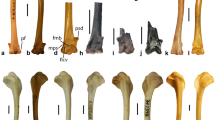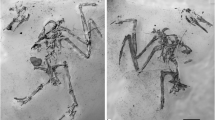Abstract
A complete tarsometatarsus of a passerine bird from the early Miocene (MN 3) of Petersbuch (Bavaria, Germany) is identified as an extinct representative of the climbing Certhioidea, i.e., a clade comprising treecreepers (Certhiidae), nuthatches and wallcreepers (Sittidae). The fossil specimen represents the so far earliest evidence of a representative of the Certhioidea and is described as †Certhiops rummeli gen. et sp. nov. Similarities to other climbing passerines are discussed.



Similar content being viewed by others
References
Alström P, Ericson PGP, Olsson U, Sundberg P (2006) Phylogeny and classification of the Avian superfamily Sylvioidea. Mol Phylogen Evol 38:381–397
Ballmann P (1969) Die Vögel aus der altburdigalen Spaltenfüllung von Wintershof (West) bei Eichstätt in Bayern. Zitteliana 1:5–60
Ballmann P (1973) Fossile Vögel aus dem Neogen der Halbinsel Gargano (Italien). Scripta Geol 17:1–75
Barker FK, Barrowclough GF, Groth JG (2002) A phylogenetic hypothesis for passerine birds: taxonomic and biogeographic implications of an analysis of nuclear DNA sequence. Proc R Soc Lond B 269:295–308
Barker FK, Cibois A, Schikler P, Feinstein J, Cracraft J (2004) Phylogeny and diversification of the largest Avian radiation. Proc Natl Acad Sci USA 101:11040–11045
Baumel JJ, Witmer LM (1993) Osteologia. In: Baumel JJ, King AS, Breazile JE, Evans HE, Vanden Berge JC (eds) Handbook of Avian anatomy: Nomina Anatomica Avium, 2nd edn. Publications of the Nuttall Ornithological Club, Cambridge, No. 23, pp 45–132
Beresford P, Barker FK, Ryan PG, Crowe TM (2005) African endemics span the tree of songbirds (Passeri): molecular systematics of several evolutionary ‘enigmas’. Proc R Soc Lond B 272:849–858
Boles WE (1993) A logrunner Orthonyx (Passeriformes: Orthonychidae) from the Miocene of Riversleigh, northwestern Queensland. Emu 93:44–49
Boles WE (1995) A preliminary analysis of the Passeriformes from Riversleigh, Northwestern Queensland, Australia, with the description of a new species of Lyrebird. Courier Forschungsinstitut Senckenberg 181:163–170
Boles WE (2005) Fossil honeyeaters (Meliphagidae) from the late Tertiary of Riversleigh, north-western Queensland. Emu 105:21–26
Brodkorb P (1978) Catalogue of fossil birds, part 5 (Passeriformes). Bull Florida State Mus Biol Sci 23:139–228
Cheneval J (2000) L’avifaune de Sansan. In: Ginsberg L (ed) La faune miocène de Sansan et son environnement. Mem Mus Nat Hist Nat 183:321–388
Chesser RT (2004) Molecular systematics of New World suboscine birds. Mol Phylogen Evol 32:11–24
Cracraft J, Barker FK, Braun M, Harshman J, Dyke GJ, Feinstein J, Stanley S, Cibois A, Schikler P, Beresford P, García-Moreno J, Sorenson MD, Yuri T, Mindell DP (2004) Phylogenetic relationships among modern birds (Neornithes)—Toward an avian tree of life. In: Cracraft J, Donoghue MJ (eds) Assembling the tree of life. Oxford University Press, Oxford, pp 468–489
Dickinson EC (ed) (2003) The Howard and Moore complete checklist of the birds of the world, 3rd edn. Princeton Univeristy Press, Princeton
Ericson PGP, Christidis L, Irestedt M, Norman JA (2002) Systematic affinities of the lyrebirds (Passeriformes: Menura), with a novel classification of the major groups of passerine birds. Mol Phylogen Evol 25:53–62
Feduccia A (1973) Evolutionary trends in the Neotropical ovenbirds and woodhewers. Ornithol Monogr 13:1–69
Fjeldså J, Irestedt M, Ericson PGP (2005) Molecular data reveal some major adaptational shifts in the early evolution of the most diverse avian family, the Furnariidae. J Ornithol 146:1–13
Irestedt M, Fjeldså J, Johansson US, Ericson PGP (2002) Systematic relationships and biogeography of the tracheophone suboscines (Aves: Passeriformes). Mol Phylogen Evol 23:499–512
Jánossy D (1974) Upper Pliocene and lower Pleistocene bird remains from Poland. Acta Zool Cracoviensia 19:531–566
Harrap S, Quinn D (1996) Tits, nuthatches & treecreepers. Helm, London
Harshman J (2007) Classification and phylogeny of birds. In: Jamieson BGM (ed) Reproductive biology and phylogeny of birds-Part A. Science Publishers, Enfield, N.H., pp 1–35
Heinroth O, Heinroth M (1924–26) Die Vögel Mitteleuropas, 1. Band: Sperlingsvögel, Rackenvögel, Kuckuck, Spechte. Reprinted by H. Deutsch, Frankfurt/Main 1966
Löhrl H (1964) Verhaltensmerkmale der Gattungen Parus (Meisen), Aegithalos (Schwanzmeisen), Sitta (Kleiber), Tichodroma (Mauerläufer) und Certhia (Baumläufer). J Ornithol 105:153–181
Löhrl H (1988) Etho-Ökologische Untersuchungen an verschiedenen Kleiberarten (Sittidae). Bonner Zool Monogr 26, 208 pp
Manegold A, Mayr G, Mourer-Chauviré C (2004) Miocene songbirds and the composition of the European Passeriform Avifauna. Auk 121:1155–1160
Mayr G, Manegold A (2006) A small suboscine-like Passeriform bird from the early Oligocene of France. Condor 108:717–720
Mein P (1999) European Miocene mammal biochronology. In: Rössner GE, Heissig K (eds) The Miocene land mammals of Europe. Pfeil, München, pp 25–38
Mlíkovský J (2002) Cenozoic birds of the world, part 1: Europe. Ninox Press, Praha
Moreno E (1986) Clave osteologica para la identification de los Passeriformes ibericos [parte] II. Ardeola 33:69–129
Moreno E (1991) Musculature of the pelvic appendages of the treecreepers (Passeriformes, Certhiidae)—Myological adaptations for tail-supported climbing. Can J Zool 69:2456–2460
Olson SL (1985) The fossil record of birds. In: Farner DS, King JR, Parkes KC (eds) Avian biology, vol VIII. Acad Press, Orlando et al, pp 79–256
Orenstein RI (1977) Morphological adaptations for bark foraging in the Australian Treecreepers (Aves: Climacteridae). PhD Thesis, University of Michigan
Parmalee PW, Klippel WE (1982) Evidence of a boreal Avifauna in middle Tennessee during the late Pleistocene. Auk 99:365–368
Raikow RJ (1993) Structure and variation in the hindlimb musculature of the woodcreepers (Aves: Passeriformes: Dendrocolaptinae). Zool J Linn Soc 107:353–399
Richardson F (1942) Adaptive modifications for tree-trunk foraging in birds. Univ California Publ Zool 46:317–368
Sheldon FH, Gill FB (1996) A reconsideration of songbird phylogeny with emphasis on the evolution of titmice and their sylvioid relatives. Syst Biol 45:473–495
Sibley CG, Ahlquist JE (1990) Phylogeny and classification of birds: a study in molecular evolution. Yale University Press, New Haven
Sibley CG, Monroe BLA (1990) Distribution and taxonomy of birds of the world. Yale University Press, New Haven
Steinbacher G (1935) Funktionell-anatomische Untersuchungen an Vogelfüßen mit Wendezehen und Rückzehen. J Ornithol 83:214–282
Steininger F (1999) The continental European Miocene—Chronostratigraphy, geochronology and biochronology of the Miocene, European Land Mammal Mega-Zones (ELMMZ) and the Miocene, Mammal-Zones (MN-Zones). In: Rössner GE, Heissig K (eds) The Miocene land mammals of Europe. Pfeil, München, pp 9–24
Vanden Berge JC, Zweers GA (1993) Myologia. In: Baumel JJ, King AS, Breazile JE, Evans HE, Vanden Berge JC (eds) Handbook of Avian anatomy: Nomina Anatomica Avium. 2nd edn. Publications of the Nuttall Ornithological Club No. 23, Cambridge, pp 189–256
Vaurie C (1957) Systematic notes on palearctic birds. No. 29, The subfamilies Tichodromadinae and Sittinae. Am Mus Nov 1854:1–26
Acknowledgements
For providing access to and loans of fossil and extant specimens I thank Michael Rummel (Naturmuseum Augsburg), Gerald Mayr (Forschungsinstitut Senckenberg) as well as Mark Adams, Joe Cooper, and Robert Prŷs-Jones (Natural History Museum London/Tring). I thank Walter Bock, Antoine Louchart, and Gerald Mayr for their comments on an earlier draft of the manuscript. This study was supported by a German Research Foundation (DFG) grant MA 2328/3-1.
Author information
Authors and Affiliations
Corresponding author
Additional information
Communicated by F. Bairlein.
Rights and permissions
About this article
Cite this article
Manegold, A. Earliest fossil record of the Certhioidea (treecreepers and allies) from the early Miocene of Germany. J Ornithol 149, 223–228 (2008). https://doi.org/10.1007/s10336-007-0263-9
Received:
Revised:
Accepted:
Published:
Issue Date:
DOI: https://doi.org/10.1007/s10336-007-0263-9




